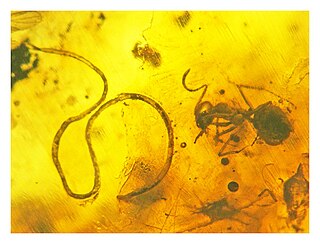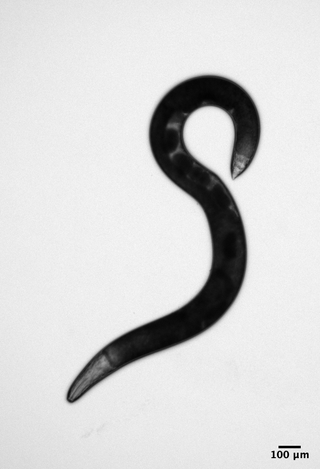
Ficus citrifolia, also known as the shortleaf fig, giant bearded fig, Jagüey, wild banyantree and Wimba tree, is a species of banyan native to southern Florida, the Caribbean, Mexico, Central America, and northern South America south to Paraguay. It is distinguished from the closely related Florida strangler fig mainly by the finer veining in the leaves.

Heterorhabditis is a genus of nematodes belonging to the order Rhabditida. All species of this genus are obligate parasites of insects, and some are used as biological control agents for the control of pest insects.

Caenorhabditis is a genus of nematodes which live in bacteria-rich environments like compost piles, decaying dead animals and rotting fruit. The name comes from Greek: caeno- ; rhabditis = rod-like.
Androdioecy is a reproductive system characterized by the coexistence of males and hermaphrodites. Androdioecy is rare in comparison with the other major reproductive systems: dioecy, gynodioecy and hermaphroditism. In animals, androdioecy has been considered a stepping stone in the transition from dioecy to hermaphroditism, and vice versa.

The nematodes, roundworms or eelworms constitute the phylum Nematoda. They are a diverse animal phylum inhabiting a broad range of environments. Most species are free-living, feeding on microorganisms, but there are many that are parasitic. The parasitic worms (helminths) are the cause of soil-transmitted helminthiases.

Bursaphelenchus is a genus of nematodes (roundworms) in the order Aphelenchida. Most are obligate mycophages, but some feed on wood, with two species, the red ring nematode and the pine wood nematode, economically significant as pests of coconut palms and of pine trees, respectively. Given that Bursaphelenchus species are usually hard to distinguish from one another except by trained nematologists with access to microscopes or DNA sequence analysis, the entire genus is put under quarantine in some countries. Where this is not the case however, these nematodes are becoming established as model organisms for nematode developmental biology, ecology and genetics.
Mononchoides is a quite common genus in the phylum of the Nematoda and by far the most diverse genus of the family of the Diplogasteridae. It has been described to live in various terrestrial habitats and is often associated with compost, dung, mud, other decaying materials and different kinds of beetles. Some have even been described from fresh water and marine habitats. In 2011, a new species has been described by Steel et al. This species was isolated from compost during the composting process and was named Mononchoides composticola.
Caenorhabditis japonica is a species of nematodes in the genus Caenorhabditis. Its genome was sequenced by the McDonnell Genome Institute at Washington University School of Medicine. This gonochoristic species is found in the 'Japonica' group, the sister clade to the 'Elegans' group, in the 'Elegans' supergroup.
Palaeonema an extinct genus of nematodes from the Early Devonian. It contains only one species, Palaeonema phyticum, and is the only member of the family Palaeonematidae. P. phyticum is the oldest known fossil nematode, and was parasitic upon the Rhynie chert plant Agalophyton.
Micoletzkya is a genus of predatory bark-beetle-associated nematodes in the family Diplogastridae. The genus was named for the Austrian nematologist Heinrich Micoletzky. As of 2013 it consists of 25 described species.

Diplogastridae, formerly Diplogasteridae, are a family of nematodes (roundworms) known from a wide range of habitats, often in commensal or parasitic associations with insects.

Pristionchus is a genus of nematodes (roundworms) in the family Diplogastridae that currently includes more than 50 described species. They are known mainly as non-parasitic associates of insects, especially beetles, while others have been reported from soil, organic matter, or rotting wood. The genus includes P. pacificus, a satellite model organism to the well-studied nematode Caenorhabditis elegans.
Paratrichodorus is a genus of terrestrial root feeding (stubby-root) nematodes in the Trichodoridae family (trichorids), being one of five genera. They are economically important plant parasites and virus vectors. The females are didelphic, and are distributed worldwide.
Levipalatum texanum is a free-living nematode (roundworm) in the family Diplogastridae. The species is androdioecious, consisting of self-fertile hermaphrodites which are morphologically females, and males. It is known from the south-eastern United States and has been found to live in association with scarab beetles, although it has also been baited from soil. Nematodes of this species can be cultured on bacterium Escherichia coli in the laboratory, and they are presumed to also feed on microorganisms in the wild. Levipalatum is a monotypic genus.

Caenorhabditis angaria is a small nematode, in the same genus as the model organism Caenorhabditis elegans. The name is from the Latin after the tendency to ride weevils. Prior to 2011, the species was referred to as C. sp. 2, C. sp. 3, and C. sp. PS1010. Its genome was sequenced at the California Institute of Technology in 2010. This species is gonochoristic. It has distinct morphology and behavior compared to C. elegans; notably, C. angaria males exhibit a spiral mating behavior. Its divergence from C. elegans is similar to the distance between humans and fish. C. castelli is its closest relative, and the two species can produce F1 hybrids.
Phasmarhabditis californica is a nematode in the family Rhabditidae. It is a lethal facultative parasite of terrestrial gastropods.
Oscheius is a genus of nematode.

Heydenius is a collective group genus of fossil mermithid nematodes from the Tertiary period that cannot be placed in extant genera.
Myolaimidae is a family of nematodes in the order Rhabditida. It consists of two genera, Myolaimus and Deleyia.

Allodiplogaster sudhausi is a free-living nematode species in the Diplogastridae family. It was described in 2008 as Koerneria sudhausi, before being moved to the genus Allodiplogaster in 2014. A. sudhausi is omnivorous. It predates on other nematodes, but can be cultured on Escherichia coli OP50 bacterium on agar.








